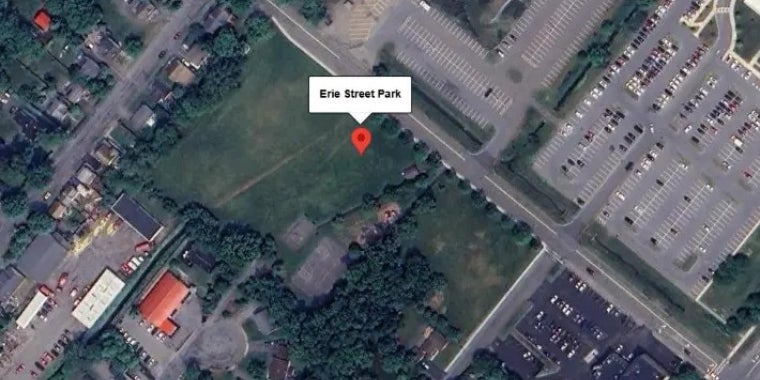
After the deluge: Some Highland Falls residents struggling to recover from July '23 floods

Any time the forecast calls for 3 or more inches of rain, the Fredricksons swing into action: They have to ensure the pump in the basement works, block the garage door to keep water out, and stack the sandbags that have become a fixture in their front garden to block runoff from the main road.
But most importantly, the Highland Falls family must monitor a large, broken concrete slab — formerly part of a retaining wall — diagonally perched between a shallow brook out back and their home’s foundation, which is covered with a tarp.
They’ve lived like this — stressing over whatever storm may come next — since a year ago on July 9, when a series of strong rainstorms within hours dumped about 8 inches of rain on this small eastern Orange County village of about 4,000 residents near the U.S. Military Academy at West Point. The deluge caused dangerous flash floods, particularly along Mountain Avenue, a winding thoroughfare that traces down a mountain and through the village. Residents like the Fredricksons, who live along the road, had their homes flooded and damaged in various ways.
Though the storms ultimately affected several other counties, Gov. Kathy Hochul identified Highland Falls as the epicenter. When floodwaters receded the next day, all eyes were on the village. Hochul and other officials came to survey the damage, hosting a news conference in the middle of mud-filled Main Street. News crews collected stories from residents. But perhaps no other household was more widely covered that day than the Fredricksons, who said they gave interviews to about eight different outlets.
Hochul described the storms as a “1,000-year event” when she spoke to the media that morning. And she vowed the state would send support to affected municipalities and residents. About a week later, she announced from the auditorium of Sacred Heart that $3 million in state relief grants would be available to qualifying homeowners.
“We stand united in our commitment to not just be there the day after when all the attention is on a community and then walk away and leave you with that hangover,” she said.
But one year later, some in Highland Falls say that is exactly what happened, as many residents are still struggling to recover.
Officials estimated only about four people in all of the town of Highlands, which includes Highland Falls, had flood insurance policies when the storms hit. And though President Joe Biden issued a major disaster declaration that opened up emergency aid to the local governments, the Federal Emergency Management Agency denied individual assistance to residents because it said the damage was not severe enough to warrant it. Local lawmakers have said the state grants for homeowners didn’t provide enough money to meet the need, and the qualifications were so strict it left out middle-class households. The U.S. Small Business Administration has made low-interest disaster loans available to homeowners, but some say it came too late, after many homeowners had taken substantial financial hits to repair their homes.
Homeowners’ recoveries notwithstanding, lawmakers have remarked on how the community has largely managed to bounce back. On a weekend in late June, Main Street was bedecked in patriotic decor ahead of July 4. People walked in and out of restaurants. Damaged roads and bridges have been restored. People still see the ghosts of the storm, but they talk mostly about how residents found support in each other. Neighbors, volunteers, responders and officials delivered supplies, cleaned out basements, and helped the village rebuild.
“There is a lot that the community is still working through, both on an individual and a broader community level, but the people there are resilient and they’ve demonstrated that during the storm, immediately after and now a year later,” state Sen. James Skoufis told the Times Union in an interview about the anniversary of the event. “But we — the state and everyone involved here — have to continue to stand by them and do more.”
The Fredricksons weren’t the only ones upset with the lack of additional relief in the state budget. It was the reason Skoufis, an eastern Orange County Democrat, voted against the spending plan and lambasted the governor in a floor speech.
He and other officials, including U.S. Rep. Pat Ryan, have repeatedly voiced harsh criticism of FEMA’s denial of individual assistance. Ryan called on FEMA’s leader to visit the area and “look impacted families in the eye and explain why she can’t marshal the resources to help them rebuild their homes.”
“Anyone with a set of eyes and a functioning brain ought to be able to look at the video and the photos … and realize that this was a catastrophic situation,” Skoufis said more recently.
FEMA’s municipal aid covers most of the cost of infrastructure repairs, but not all of it: 75 percent comes from the federal agency, 12.5 percent is paid by the state, and the municipality pays the other 12.5 percent. In interviews with the Times Union in late June, Skoufis and local Assemblyman Chris Eachus stressed the local portion is still a heavy burden for the small towns.
As a result, Highland Falls and other impacted communities have had to raise their tax levies to pay for repairs not covered by flood relief. Highland Falls Mayor Joe D’Onofrio told News12 that the Village Board recently approved a 4 percent tax increase. Taxes in the town of Highlands increased more than 10 percent, according to the Town Board’s 2024 budget.
Skoufis and Eachus said their offices are exploring if there are creative ways to find further relief for these communities.
Another challenge with the FEMA aid is how it can be used. Eachus said the money has to be used to restore infrastructure to its previous condition.
Some of these municipalities recently awarded NY Forward state grants will have to use that money to rebuild elements of their infrastructure, he said.
The elected officials all said that the storm taught many lessons about the need for more resilient infrastructure and better local planning. But they also underscored that the emergency response during the storms was commendable, including from mutual aid networks, local fire departments and first responders, as well as the state’s emergency response teams.
“That element of all this, I thought, worked really well,” Skoufis said. “It’s easy to just focus on the areas that need improvement, but I don’t think it should be lost to anyone that the first responders got to the scene and were helping people and were assisting with the rebuild at an extremely rapid and impressive rate.”

